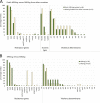Genetic Characteristics of Methicillin-Resistant Staphylococcus argenteus Isolates Collected in the Dutch National MRSA Surveillance from 2008 to 2021
- PMID: 36005448
- PMCID: PMC9603934
- DOI: 10.1128/spectrum.01035-22
Genetic Characteristics of Methicillin-Resistant Staphylococcus argenteus Isolates Collected in the Dutch National MRSA Surveillance from 2008 to 2021
Abstract
Staphylococcus argenteus is a recently described member of the Staphylococcus aureus complex (SAC) and is associated with human disease. The frequency and intensity of infections caused by S. argenteus are similar to those of Staphylococcus aureus. S. argenteus can harbor antibiotic resistance genes and a variety of virulence factors analogous to methicillin-resistant S. aureus (MRSA). The aim of our study was to analyze a collection of isolates in the Dutch national MRSA surveillance from January 2008 until March 2021 that were nontypeable by multilocus variable-number tandem-repeat analysis (MLVA). Matrix-assisted laser desorption ionization-time of flight mass spectrometry (MALDI-ToF MS) was used for identifying the S. argenteus isolates, and whole-genome sequencing and SeqSphere were used to generate an in-house whole-genome multilocus sequence typing (wgMLST) scheme for typing the isolates. Furthermore, the presence of antibiotic resistance genes, replicons, and virulence genes was determined. Of 52,467 isolates submitted as MRSA from January 2008 until March 2021, 64 isolates (0.12%) were nontypeable with MLVA, and 54 of them were identified with mass spectrometry (MALDI-ToF MS) as S. argenteus. It appeared in retrospect that the first methicillin-resistant S. argenteus (MRSArg) was already submitted in 2008. An in-house-developed S. argenteus wgMLST scheme revealed that S. argenteus isolates clustered in 5 genomic groups which were characterized by distinct MLST types, resistomes, plasmid replicon families, and virulence factors. All but one isolate carried the staphylococcal chromosomal cassette mec (SCCmec) type IV harboring the methicillin resistance gene mecA and represent MRSArg. Most of the isolates with SCCmec subtype IVc(2B) had a trimethoprim resistance gene, dfrG, and harbored a blaZ-carrying plasmid, and most MRSArg isolates have the immune-modulating genes scn and sak. Nine of the 47 isolates carried enterotoxin-encoding genes seg, sei, sem, seo, and seu, which might be able to cause food poisoning. In some persons there was long-term persistence of MRSArg, and there were several genetically related MRSArg isolates in people living in close proximity, suggesting direct human-human transmission. IMPORTANCE We show that MRSArg has been circulating in the Netherlands since at least 2008. Although MRSArg is distinct from MRSA, it has a comparable population structure and carries similar resistance and virulence genes. The Dutch national MRSA surveillance has been expanded to include other methicillin-resistant members of the S. aureus complex, such as S. argenteus and Staphylococcus schweitzeri.
Keywords: MRSArg; SCCmec subtype IVc(2B); SCCmec type IV; Staphylococcus argenteus; enterotoxins; resistance genes; virulence factors.
Conflict of interest statement
The authors declare no conflict of interest.
Figures



Similar articles
-
Occurrence and characteristics of methicillin-resistant and -susceptible Staphylococcus aureus and methicillin-resistant coagulase-negative staphylococci from Japanese retail ready-to-eat raw fish.Int J Food Microbiol. 2012 Jun 1;156(3):286-9. doi: 10.1016/j.ijfoodmicro.2012.03.022. Epub 2012 Mar 28. Int J Food Microbiol. 2012. PMID: 22541390
-
Next-Generation Sequence Analysis Reveals Transfer of Methicillin Resistance to a Methicillin-Susceptible Staphylococcus aureus Strain That Subsequently Caused a Methicillin-Resistant Staphylococcus aureus Outbreak: a Descriptive Study.J Clin Microbiol. 2017 Sep;55(9):2808-2816. doi: 10.1128/JCM.00459-17. Epub 2017 Jul 5. J Clin Microbiol. 2017. PMID: 28679522 Free PMC article.
-
Transmission events and antimicrobial susceptibilities of methicillin-resistant Staphylococcus argenteus in Stockholm.Clin Microbiol Infect. 2019 Oct;25(10):1289.e5-1289.e8. doi: 10.1016/j.cmi.2019.06.003. Epub 2019 Jun 20. Clin Microbiol Infect. 2019. PMID: 31229597
-
Implications of identifying the recently defined members of the Staphylococcus aureus complex S. argenteus and S. schweitzeri: a position paper of members of the ESCMID Study Group for Staphylococci and Staphylococcal Diseases (ESGS).Clin Microbiol Infect. 2019 Sep;25(9):1064-1070. doi: 10.1016/j.cmi.2019.02.028. Epub 2019 Mar 11. Clin Microbiol Infect. 2019. PMID: 30872103 Review.
-
Methicillin-Resistant Staphylococcus aureus: Molecular Characterization, Evolution, and Epidemiology.Clin Microbiol Rev. 2018 Sep 12;31(4):e00020-18. doi: 10.1128/CMR.00020-18. Print 2018 Oct. Clin Microbiol Rev. 2018. PMID: 30209034 Free PMC article. Review.
Cited by
-
Prevalence and Characteristics of Invasive Staphylococcus argenteus among Patients with Bacteremia in Hong Kong.Microorganisms. 2023 Sep 28;11(10):2435. doi: 10.3390/microorganisms11102435. Microorganisms. 2023. PMID: 37894094 Free PMC article.
-
Staphylococcus argenteus bacteremia in the Republic of Korea.Microbiol Spectr. 2024 Feb 6;12(2):e0279823. doi: 10.1128/spectrum.02798-23. Epub 2024 Jan 10. Microbiol Spectr. 2024. PMID: 38197655 Free PMC article.
-
The Staphylococcus aureus complex: implications for the clinical microbiology laboratory.J Clin Microbiol. 2025 Jul 9;63(7):e0127624. doi: 10.1128/jcm.01276-24. Epub 2025 Jun 4. J Clin Microbiol. 2025. PMID: 40464548 Free PMC article. Review.
-
Characterization of Staphylococcus argenteus in Christchurch, New Zealand, and comparison to global strains.Access Microbiol. 2025 Jul 16;7(7):000916.v4. doi: 10.1099/acmi.0.000916.v4. eCollection 2025. Access Microbiol. 2025. PMID: 40672796 Free PMC article.
References
-
- Schutte AHJ, Strepis N, Zandijk WHA, Bexkens ML, Bode LGM, Klaassen CHW. 2021. Characterization of Staphylococcus roterodami sp. nov., a new species within the Staphylococcus aureus complex isolated from a human foot infection. Int J Syst Evol Microbiol 71. doi:10.1099/ijsem.0.004996. - DOI - PubMed
-
- McDonald M, Dougall A, Holt D, Huygens F, Oppedisano F, Giffard PM, Inman-Bamber J, Stephens AJ, Towers R, Carapetis JR, Currie BJ. 2006. Use of a single-nucleotide polymorphism genotyping system to demonstrate the unique epidemiology of methicillin-resistant Staphylococcus aureus in remote aboriginal communities. J Clin Microbiol 44:3720–3727. doi:10.1128/JCM.00836-06. - DOI - PMC - PubMed
-
- Tong SYC, Schaumburg F, Ellington MJ, Corander J, Pichon B, Leendertz F, Bentley SD, Parkhill J, Holt DC, Peters G, Giffard PM. 2015. Novel staphylococcal species that form part of a Staphylococcus aureus-related complex: the non-pigmented Staphylococcus argenteus sp. nov. and the non-human primate-associated Staphylococcus schweitzeri sp. nov. Int J Syst Evol Microbiol 65:15–22. doi:10.1099/ijs.0.062752-0. - DOI - PMC - PubMed
-
- Holt DC, Holden MTG, Tong SYC, Castillo-Ramirez S, Clarke L, Quail MA, Currie BJ, Parkhill J, Bentley SD, Feil EJ, Giffard PM. 2011. A very early-branching Staphylococcus aureus lineage lacking the carotenoid pigment staphyloxanthin. Genome Biol Evol 3:881–895. doi:10.1093/gbe/evr078. - DOI - PMC - PubMed
MeSH terms
Substances
LinkOut - more resources
Full Text Sources
Medical
Miscellaneous

